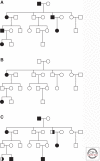Genetics of Parkinson's disease
- PMID: 22315721
- PMCID: PMC3253033
- DOI: 10.1101/cshperspect.a008888
Genetics of Parkinson's disease
Abstract
Fifteen years of genetic research in Parkinson's disease (PD) have led to the identification of several monogenic forms of the disorder and of numerous genetic risk factors increasing the risk to develop PD. Monogenic forms, caused by a single mutation in a dominantly or recessively inherited gene, are well-established, albeit relatively rare types of PD. They collectively account for about 30% of the familial and 3%-5% of the sporadic cases. In this article, we will summarize the current knowledge and understanding of the molecular genetics of PD. In brief, we will review familial forms of PD, basic genetic principles of inheritance (and their exceptions in PD), followed by current methods for the identification of PD genes and risk factors, and implications for genetic testing.
Figures


Similar articles
-
Genetics of Parkinson's disease: the yield.Parkinsonism Relat Disord. 2014 Jan;20 Suppl 1:S35-8. doi: 10.1016/S1353-8020(13)70011-7. Parkinsonism Relat Disord. 2014. PMID: 24262184 Review.
-
The role of monogenic genes in idiopathic Parkinson's disease.Neurobiol Dis. 2019 Apr;124:230-239. doi: 10.1016/j.nbd.2018.11.012. Epub 2018 Nov 15. Neurobiol Dis. 2019. PMID: 30448284 Free PMC article. Review.
-
Genetic basis of Parkinson disease.Neurosurg Focus. 2010 Jan;28(1):E7. doi: 10.3171/2009.10.FOCUS09220. Neurosurg Focus. 2010. PMID: 20043722
-
The genetic background of Parkinson's disease: current progress and future prospects.Acta Neurol Scand. 2016 Nov;134(5):314-326. doi: 10.1111/ane.12563. Epub 2016 Feb 12. Acta Neurol Scand. 2016. PMID: 26869347 Review.
-
Genetics of Parkinson's disease.Semin Neurol. 2011 Nov;31(5):433-40. doi: 10.1055/s-0031-1299782. Epub 2012 Jan 21. Semin Neurol. 2011. PMID: 22266881 Review.
Cited by
-
Parkinson's Disease in a Dish: What Patient Specific-Reprogrammed Somatic Cells Can Tell Us about Parkinson's Disease, If Anything?Stem Cells Int. 2012;2012:926147. doi: 10.1155/2012/926147. Epub 2012 Dec 20. Stem Cells Int. 2012. PMID: 23316244 Free PMC article.
-
Allogenic microglia replacement: A novel therapeutic strategy for neurological disorders.Fundam Res. 2023 Mar 27;4(2):237-245. doi: 10.1016/j.fmre.2023.02.025. eCollection 2024 Mar. Fundam Res. 2023. PMID: 38933508 Free PMC article. Review.
-
A Virtual Cohort Study of Individuals at Genetic Risk for Parkinson's Disease: Study Protocol and Design.J Parkinsons Dis. 2020;10(3):1195-1207. doi: 10.3233/JPD-202019. J Parkinsons Dis. 2020. PMID: 32568109 Free PMC article.
-
Neuroprotective effects of the cultivated Chondrus crispus in a C. elegans model of Parkinson's disease.Mar Drugs. 2015 Apr 14;13(4):2250-66. doi: 10.3390/md13042250. Mar Drugs. 2015. PMID: 25874922 Free PMC article.
-
Novel Pharmacotherapies in Parkinson's Disease.Neurotox Res. 2021 Aug;39(4):1381-1390. doi: 10.1007/s12640-021-00375-5. Epub 2021 May 18. Neurotox Res. 2021. PMID: 34003454 Free PMC article. Review.
References
-
- Ahn TB, Kim SY, Kim JY, Park SS, Lee DS, Min HJ, Kim YK, Kim SE, Kim JM, Kim HJ, et al. 2008. α-Synuclein gene duplication is present in sporadic Parkinson disease. Neurology 70: 43–49 - PubMed
-
- Bertoncini CW, Fernandez CO, Griesinger C, Jovin TM, Zweckstetter M 2005. Familial mutants of α-synuclein with increased neurotoxicity have a destabilized conformation. J Biol Chem 280: 30649–30652 - PubMed
-
- Bonifati V, Rohe CF, Breedveld GJ, Fabrizio E, De Mari M, Tassorelli C, Tavella A, Marconi R, Nicholl DJ, Chien HF, et al. 2005. Early-onset parkinsonism associated with PINK1 mutations: Frequency, genotypes, and phenotypes. Neurology 65: 87–95 - PubMed
Publication types
MeSH terms
Substances
LinkOut - more resources
Full Text Sources
Other Literature Sources
Medical
Molecular Biology Databases
